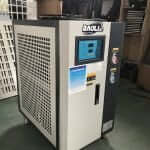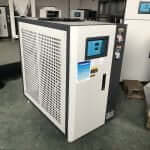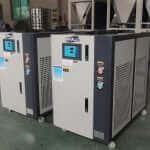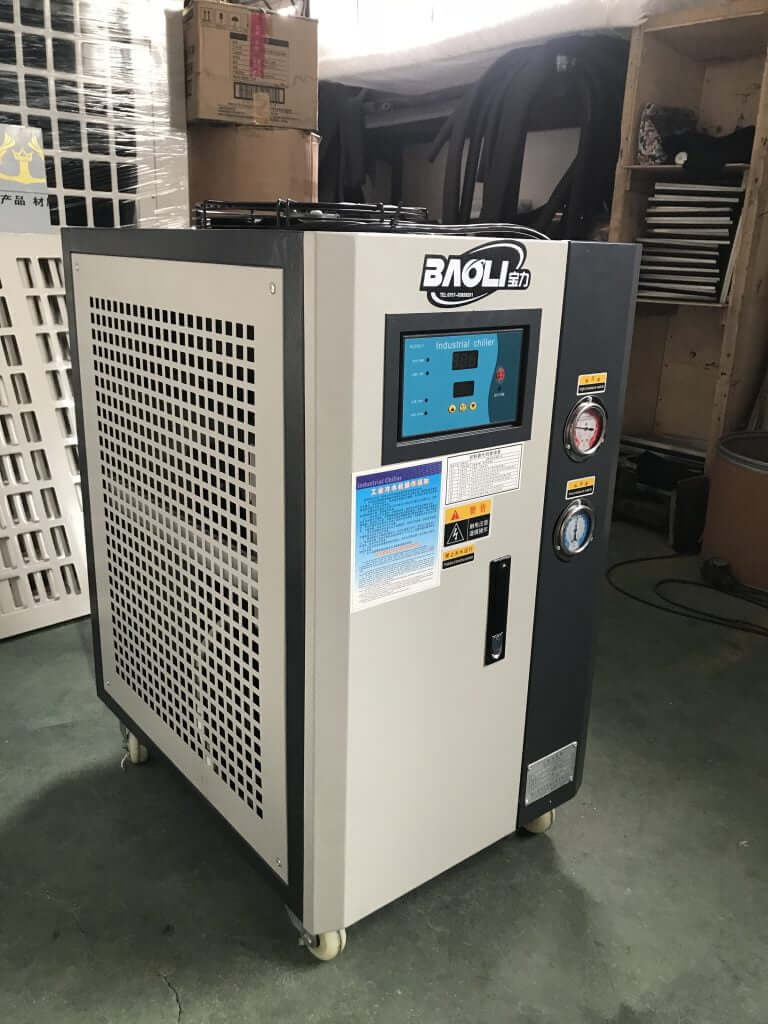Introduction:what is aquarium chiller?
수족관은 우리 생활 공간에 단지 아름다운 추가물이 아닙니다. 그들은 수중 생물의 건강과 안녕을 보장하기 위해 세심한 유지 관리가 필요한 소형 생태계입니다. 안정적이고 적합한 수생 환경을 유지하는 데 중요한 요소 중 하나는 적절한 온도 제어입니다. 이것은 수족관 냉각기가 작동하는 곳입니다. 수족관 냉각기는 탱크의 수온이 원하는 수준 이상으로 올라갈 때 탱크의 수온을 낮추도록 설계된 장치로, 많은 수생 생물이 번성하는 데 필요한 자연 조건을 모방합니다. 섬세한 산호와 물고기가 있는 바닷물 암초 탱크나 온도에 민감한 종들이 있는 담수 수족관이 있든 상관없이, 수중 생물의 스트레스, 질병, 심지어 사망까지 예방하려면 올바른 냉각기를 선택하는 것이 필수적입니다.
선택할 때 고려해야 할 요소
수족관의 크기는 적절한 냉각기 용량을 결정하는 주요 요소입니다. 더 큰 탱크에는 더 많은 양의 물을 효과적으로 냉각시키기 위해 더 강력한 냉각기가 필요합니다. 일반적으로 탱크의 부피를 갤런이나 리터 단위로 계산해야 합니다. 예를 들어, 작은 20 – 갤런 탱크는 100에 비해 냉각 요구 사항이 다릅니다. – 갤런 탱크. 탱크에 비해 냉각기가 너무 작으면 원하는 온도를 유지하는 데 어려움을 겪게 되어 물고기와 식물에 해로울 수 있는 변동이 발생할 수 있습니다. 반면, 너무 큰 냉각기는 비용 낭비일 뿐만 아니라 과도한 냉각을 유발하여 부정적인 영향을 미칠 수도 있습니다. 효율적이고 정확한 온도 제어를 보장하려면 적절한 탱크 크기에 맞는 냉각기를 찾는 것이 중요합니다.
다양한 수생 종은 특정 온도 선호도를 가지고 있습니다. 일부 물고기와 산호는 시원한 물에서 번성하는 반면, 일부 물고기와 산호는 약간 더 따뜻한 환경을 선호합니다. 예를 들어, 열대어는 일반적으로 75°F에서 82°F 사이의 온도에서 잘 지내는 반면, 일부 산호종과 같은 특정 해양 무척추동물은 약 78°F의 더 정확한 온도 범위가 필요할 수 있습니다. 수족관에 있는 특정 유기체의 온도 요구 사항을 조사하는 것이 중요합니다. 다양한 수중 생물 군집이 있는 경우 대부분의 수중 생물에게 적합한 절충 온도를 찾아야 할 수도 있습니다. 귀하가 선택하는 냉각기는 원하는 온도 범위를 정확하게 유지할 수 있어야 합니다. 일부 고급 냉각기에는 온도 설정이 프로그래밍 가능하여 수족관 거주자의 필요에 따라 온도를 맞춤 설정할 수도 있습니다.
수족관 냉각기를 선택할 때 에너지 효율성은 중요한 고려 사항입니다. 에너지 효율성이 더 높은 냉각기는 장기적으로 전기 요금을 절약할 뿐만 아니라 환경 친화적이기도 합니다. 에너지 효율 등급이 높은 냉각기를 찾으십시오. 이들은 종종 효과적인 냉각을 제공하면서도 전력 소비를 최소화하기 위해 고급 기술과 구성 요소를 사용합니다. 찾아야 할 일부 기능에는 효율적인 압축기, 우수한 단열재, 실제 온도 요구 사항에 따라 냉각 출력을 조정하는 지능형 온도 제어 시스템이 포함됩니다. 에너지 효율적인 냉각기에 투자하면 처음에는 비용이 조금 더 들 수 있지만 시간이 지나면서 상당한 비용 절감 효과를 얻을 수 있습니다. 특히 지속적인 냉각이 필요한 대형 수족관의 경우 더욱 그렇습니다.
냉각기의 소음 수준은 수중 생물과 주변 환경 모두에 심각한 영향을 미칠 수 있습니다. 시끄러운 냉각기는 물고기에게 스트레스를 주어 행동과 건강에 영향을 미칠 수 있습니다. 가정 환경에서는 시끄러운 냉각 장치가 거주자에게 불쾌감을 줄 수도 있습니다. 냉각기를 선택할 때 조용히 작동하도록 설계된 모델을 찾으십시오. 일부 제조업체는 소음을 줄이기 위해 소음 감소 재료와 고급 모터 기술을 사용합니다. 리뷰를 읽고 다른 수족관 소유자에게 다양한 냉각기의 소음 수준에 대한 권장 사항을 요청하는 것이 좋습니다. 조용한 냉각기는 수족관과 집에 더욱 평화롭고 편안한 환경을 제공합니다.
수족관 냉각기에 관해서는 신뢰할 수 있는 제품을 갖춘 평판이 좋은 브랜드를 선택하는 것이 필수적입니다. 잘 알려진 브랜드는 고품질, 내구성 및 신뢰성 있는 장비를 생산한 실적을 보유할 가능성이 더 높습니다. 한동안 시장에 나와 있었고 긍정적인 고객 리뷰를 받은 브랜드를 찾으세요. 신뢰할 수 있는 냉각기는 고장나거나 오작동할 가능성이 적으며, 이는 수족관에 재앙이 될 수 있습니다. 또한 더 나은 보증과 고객 지원도 함께 제공되는 경우가 많습니다. 연구 개발에 투자하는 브랜드는 고급 기능과 더 나은 성능을 제공할 가능성이 더 높습니다. 수족관에 장기적으로 신뢰할 수 있는 서비스를 제공할 냉각기에 투자하고 있는지 확인하기 위해 숙제를 하고 다양한 브랜드를 조사하십시오.
수족관 냉각기 선택 지침
구매하기 전에 철저한 조사를 수행하는 것이 중요합니다. 온라인에서 제품 리뷰, 비교 및 전문가 의견을 찾아보세요. 수중 취미에 관한 수족관 포럼과 웹사이트는 훌륭한 정보 소스입니다. 다양한 냉각기를 사용해 본 다른 수족관 소유자의 경험에 대해 읽어보십시오. 이를 통해 다양한 모델의 성능, 안정성 및 잠재적인 문제에 대한 통찰력을 얻을 수 있습니다. 냉각기가 온도를 얼마나 잘 유지하는지, 에너지 소비량, 소음 수준, 설치 및 유지 관리의 용이성과 같은 세부 사항에 주의하십시오. 가능한 한 많은 정보를 수집하면 더 많은 정보를 바탕으로 결정을 내리고 특정 요구 사항에 맞는 냉각기를 선택할 가능성이 높아집니다.
수족관 관리가 처음이거나 어떤 냉각기가 귀하의 설정에 적합한지 확실하지 않은 경우 수족관 전문가나 숙련된 애호가와 상담하는 것이 도움이 될 수 있습니다. 그들은 지식과 경험을 바탕으로 귀중한 조언을 제공할 수 있습니다. 자신이 판매하는 제품에 대해 잘 알고 있는 수족관 매장 직원도 안내를 제공할 수 있습니다. 그들은 귀하의 탱크 크기, 수족관의 종 및 예산에 따라 특정 모델을 추천할 수 있습니다. 또한 지역 수족관 클럽이나 온라인 커뮤니티에 가입하면 자신의 통찰력과 경험을 공유할 수 있는 숙련된 개인 네트워크에 액세스할 수 있습니다. 건강한 수중 환경을 유지하는 데 더 많은 경험이 있는 사람들에게 질문하고 조언을 구하는 것을 두려워하지 마십시오.
고품질 냉각기를 선택하는 것도 중요하지만 예산도 고려해야 합니다. 수족관 냉각기는 기능, 용량 및 브랜드에 따라 다양한 가격으로 제공됩니다. 자신에게 편한 예산을 설정하세요. 하지만 저렴한 모델이 항상 최고의 성능과 안정성을 제공하는 것은 아니라는 점도 염두에 두세요. 비용과 품질의 균형을 맞추는 것이 좋습니다. 예산 내에서 가격 대비 좋은 가치를 제공하는 냉각기를 찾으십시오. 에너지 소비 및 잠재적인 유지 관리 비용을 포함한 장기 비용도 고려하십시오. 때로는 더 나은 품질의 냉각기에 조금 더 초기 투자를 하면 더 효율적인 냉각을 제공하고 고장 횟수를 줄여 장기적으로 비용을 절약할 수 있습니다.
-
Installation and Maintenance
냉각기 설치 및 유지 관리의 용이성과 복잡성을 생각해 보십시오. 일부 냉각기는 쉽게 설치할 수 있도록 설계되었으며 명확한 지침과 필요한 모든 부속품이 함께 제공됩니다. 다른 경우에는 더 많은 기술 지식과 설치 기술이 필요할 수 있습니다. 귀하의 능력과 설치를 위해 전문가를 고용해야 하는지 여부를 고려하십시오. 유지 관리 측면에서는 청소가 쉽고 서비스를 위한 접근 가능한 구성 요소가 있는 냉각기를 찾으십시오. 냉각기를 효율적으로 작동시키고 수명을 연장하려면 정기적인 유지 관리가 필수적입니다. 제조업체가 유지 관리 지침을 제공하는지, 교체 부품을 쉽게 구할 수 있는지 확인하세요. 설치 및 유지 관리가 쉬운 냉각기는 장기적으로 시간과 노력을 절약하고 계속해서 좋은 성능을 발휘하도록 보장합니다.
올바른 수족관 냉각기를 선택하기 위한 구체적인 단계
-
수족관 요구 사항 결정
– 탱크 크기 측정: 수족관의 길이, 너비 및 높이를 정확하게 측정하여 부피를 갤런 또는 리터 단위로 계산합니다. 이것이 적합한 용량의 냉동기를 찾는 출발점이 될 것입니다.
– 종을 연구하세요’ 온도 요구사항: 수족관에 있는 물고기, 식물 및 기타 유기체의 유형을 식별하고 이상적인 온도 범위를 조사하십시오. 다양한 커뮤니티가 있는 경우 대부분의 주민을 수용할 수 있는 공통 온도 범위를 찾으십시오.
-
예산 설정
– Decide how much you are willing to spend on the chiller. Consider not only the initial purchase price but also the long-term costs such as energy consumption and potential maintenance. Remember that a higher-quality chiller may cost more upfront but could save you money in the long run.
-
Research and Shortlist
– Online research: Look for aquarium chiller reviews on reliable websites, forums, and social media groups dedicated to aquariums. Read about the performance, reliability, and user experiences with different models.
– Ask for recommendations: Talk to aquarium store employees, experts, and other hobbyists. They can provide insights based on their own experiences and knowledge.
– 후보 목록 만들기: 연구 및 권장 사항을 바탕으로 용량, 온도 제어, 에너지 효율성 및 소음 수준 측면에서 요구 사항을 충족하는 것으로 보이는 몇 가지 냉각기 모델을 후보 목록에 추가하세요.
-
에너지 효율 등급 확인
– 에너지 스타 등급이나 기타 에너지 효율성 지표를 찾아보세요. 귀하의 예산에 맞는 가장 에너지 효율적인 옵션을 찾으려면 최종 후보에 오른 냉각기의 전력 소비량을 비교하십시오.
-
소음 수준 평가
– 리뷰를 읽고 최종 후보에 오른 냉각기의 소음 수준에 대해 문의하십시오. 가능하다면 특정 모델이 얼마나 조용하거나 시끄러운지 보여주는 동영상이나 시연을 찾아보세요. 수중 생물에 스트레스를 주고 생활 환경을 방해하지 않도록 조용히 작동하는 냉각기를 선택하십시오.
-
브랜드와 신뢰성을 고려하세요
– 최종 후보에 오른 냉각기 브랜드를 조사하세요. 믿을 수 있고 내구성이 뛰어난 수족관 장비를 생산하는 것으로 좋은 평판을 얻고 있는 브랜드를 찾아보세요. 브랜드의 애프터 서비스 및 보증 정책에 대한 피드백은 고객 리뷰를 확인하세요.
-
설치 및 유지 관리 요구 사항 검토
– 설치 과정을 이해하려면 제품 설명서나 온라인 설명을 읽어보세요. 설치에 필요한 기술과 도구가 있는지 또는 전문가를 고용해야 하는지 고려하십시오.
– 청소나 서비스가 필요할 수 있는 필터, 코일 및 기타 구성 요소에 접근이 가능하며 유지 관리가 쉬운 냉각기를 찾으십시오. 제조업체가 명확한 유지 관리 지침을 제공하는지, 교체 부품을 쉽게 구할 수 있는지 확인하세요.
-
최종 결정을 내리세요
– 최종 후보에 오른 각 냉각기에 대한 모든 요소를 비교하십시오. 예산 내에서 성능, 신뢰성, 에너지 효율성, 소음 수준, 설치 및 유지 관리 용이성 사이에서 가장 좋은 균형을 제공하는 것이 무엇인지 고려하십시오. 종합적인 평가를 바탕으로 최종 결정을 내리고 선택한 수족관 냉각기를 구입하십시오.
수족관 냉각기 설치 고려 사항
- 공간 요구 사항: 냉각기를 설치할 수 있도록 수족관 주변에 충분한 공간이 있는지 확인하십시오. 통풍이 잘되고 비좁지 않은 곳에 놓아야 합니다. 냉각기는 열을 방출해야 하므로 공기 흐름이 제한된 밀폐된 공간에 설치해서는 안 됩니다.
- 탱크와의 근접성: 냉각기는 물 순환에 필요한 튜브 길이를 최소화하기 위해 수족관에 최대한 가깝게 위치해야 합니다. 튜브가 길면 압력 강하가 증가하고 잠재적으로 냉각기 효율에 영향을 미칠 수 있습니다. 그러나 유지 관리 및 접근을 위해 냉각기 주변에 충분한 공간이 있는지 확인하십시오.
- 직사광선 및 열원을 피하세요: 직사광선에 노출되는 장소나 라디에이터, 히터, 열을 많이 발생하는 가전제품 등 열원 근처에 냉각기를 설치하지 마세요. 이로 인해 냉각기가 물을 냉각하는 데 필요한 것보다 더 열심히 작동할 수 있으며 심지어 냉각기 자체가 과열될 수도 있습니다.
- 올바른 튜브 크기: 냉각기 제조업체에서 권장하는 튜브 크기를 사용하십시오. 잘못된 튜브 직경은 물의 유속과 압력에 영향을 미칠 수 있으며, 이는 결국 냉각기 성능에 영향을 미칠 수 있습니다. 튜브의 품질이 양호하고 결함이나 꼬임이 없는지 확인하십시오.
- 안전한 연결: 모든 튜브 연결은 누출을 방지하기 위해 안전하게 이루어져야 합니다. 단단히 밀봉하려면 적절한 피팅과 클램프를 사용하십시오. 누수로 인해 물이 낭비될 뿐만 아니라 혼란을 야기하고 바닥이나 주변 가구를 손상시킬 수도 있습니다. 설치 후 냉각기를 잠시 가동하고 연결부를 관찰하여 누출 여부를 확인하십시오.
- Water Flow Direction: Follow the correct water flow direction as indicated in the chiller’s installation manual. Incorrect flow direction can lead to inefficient cooling or even damage the chiller’s internal components. Some chillers may have specific requirements for the inlet and outlet of water, so make sure to connect them correctly.
- Voltage and Amperage Requirements: Check the electrical requirements of the chiller and make sure that the power supply in your area can meet those requirements. Using the wrong voltage or insufficient amperage can cause the chiller to malfunction or not operate properly. It may also damage the electrical components of the chiller and pose a safety hazard.
- Grounding: Ensure that the chiller is properly grounded to prevent electrical shocks. Most electrical appliances come with a grounding wire or a grounding plug. Make sure to connect it to a properly grounded electrical outlet. If in doubt, consult an electrician to check the grounding of your electrical system.
- Power Cord Length and Placement: The power cord should be long enough to reach the electrical outlet without being stretched or strained. Avoid running the power cord across high-traffic areas or in a way that it can be easily damaged. If possible, use a cord cover or conduit to protect the power cord and make it look more organized.
-
Initial Startup and Testing
- Read the Manual: Before starting the chiller for the first time, carefully read the manufacturer’s instructions regarding the initial startup procedure. This may include steps such as filling the chiller with water (if required), priming the pump, and setting the initial temperature settings.
- Monitor Temperature: After starting the chiller, closely monitor the water temperature in the aquarium. Check if the chiller is able to reach and maintain the desired temperature within a reasonable time. If the temperature does not seem to be changing as expected or if there are any unusual fluctuations, turn off the chiller and check for any installation errors or problems.
- Check for Noise and Vibrations: Listen for any abnormal noise or vibrations coming from the chiller during operation. Excessive noise or vibrations may indicate a problem with the installation, such as improper leveling or a loose component. If you notice any issues, turn off the chiller and investigate further to ensure proper operation and longevity of the device.
결론
Choosing the right aquarium chiller is a crucial decision that can have a significant impact on the health and well-being of your aquatic pets. By considering factors such as tank size and capacity, water temperature requirements, energy efficiency, noise level, brand and reliability, and following the specific steps for selection and installation, you can make an informed choice. A well-chosen and properly installed chiller will help maintain a stable and suitable aquatic environment, allowing your fish, plants, and other organisms to thrive. Remember that investing time and effort in choosing and installing the right chiller is an investment in the long-term success of your aquarium and the enjoyment you get from observing and caring for your aquatic friends. So, take your time, do your homework, and make the best choices for your unique aquarium setup.
To learn more about how chillers work and If you’re interested in our chiller, request a quote,
pls sent your E-mail to info@topwaterchiller.com, or call +(86) 139 2883 9015 .















